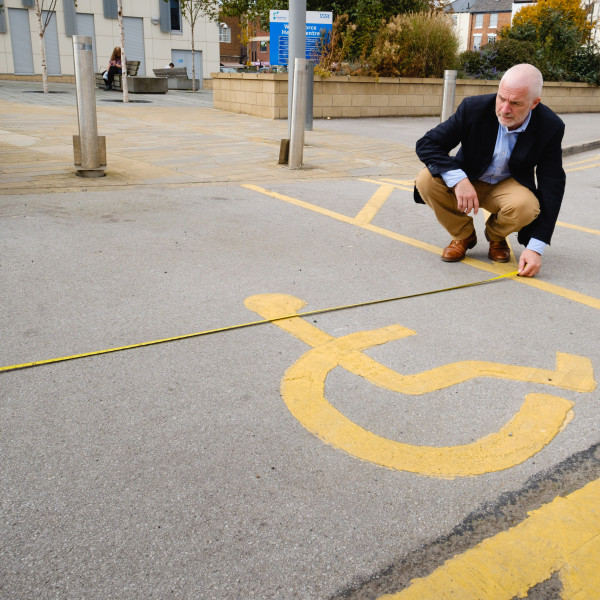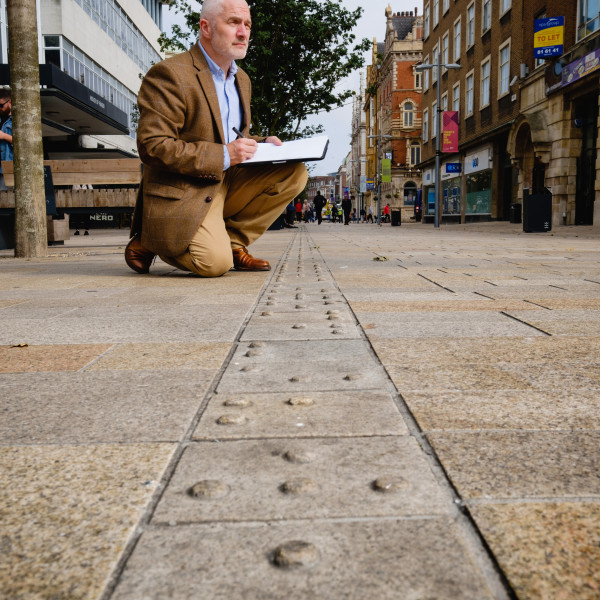From fish shops to access audits
Ian’s career began in his family’s business, running four fish and chips shops in Yorkshire. At that time, accessibility wasn’t part of the national agenda. But when the Disability Discrimination Act (DDA) 1995 came in, it was the first UK legislation to protect disabled people against various forms of discrimination. Things were starting to change.
Through the disabilities of two close family members, Ian had first-hand experience of access challenges. So when a friend – an evaluation surveyor – approached him to attend a course on accessibility for businesses, he took the chance. Ian found the course fascinating, and quickly realised he knew nothing about the subject.
Not long after, Ian and his business partners set up a company to carry out access audits. In the first year, they had very few paying clients. That’s because at the time, nobody really understood what accessibility was all about. It was all new. But, after a few free projects to build a portfolio, the business began to take off.
An overview of the legislation
In England, Scotland and Wales, the DDA 1995 was replaced by The Equality Act 2010. Neither piece of legislation provides a specification in terms of design for accessibility. Instead, they communicate that disabled people should not be discriminated against, and in terms of the physical features of buildings, reasonable adjustments should be made.
In UK building regulations, Part M provides information about the ease of access and use of buildings, including facilities for disabled users, and the ability to move through a building easily. Part K deals with physical adjustments such as stairs, ramps, etc.
The Approved Document M (ADM) building regulation contains a table of regulations and, at a high level, what must be put in place. It also provides guidance on how to meet the regulation. Whilst the ADM is concerned with new builds and extensions, the Equality Act 2010 ensures physical features do not discriminate against disabled people. Where they do, organisations must remove, avoid, or adjust those features.

The challenge of accessible signage
Two people can have the same disability, but their needs in the built environment can be completely different. For example, two people with impaired vision will have two different viewing distances. Signage design needs to be as accessible and practicable as possible in any given scenario. It’s not a case of one size fits all. For wayfinding designers and architects, The Sign Design Guide, which has been around a while now, was recently updated and is still considered the best starting point.
As an access consultant, Ian’s focus is to ensure accessibility for a broad range of people and disabilities in signage and other aspects of the built environment. When Ian is reviewing signage, he looks at whether it makes sense, and if it’s logical. He compares it with a proofreading exercise. It’s like checking an email before you send it. All too often the designers and building operators know what the signage means, but there are one or two signs which are easy to confuse. For instance, arrows positioned at 45 degrees are easy to misunderstand – do they mean take the next staircase or turn left?
Contrast is another important aspect of signage. Does the text contrast with the sign board? Can you clearly view the signage? If it’s located at a decision point, what’s the impact on the sign visibility if a lot of people are standing there? It’s important to understand the visitor journey – how people move through the space – and what happens when they come to a sign.
Both the European and International standards recommend that Braille and tactile information is included on handrails for stairs. In contrast, the UK standard BS 8300 makes no mention of this. Putting this information on handrails potentially creates issues around how people access it. For example, what happens if they suddenly stop to read it on a busy stairway? Which direction should it be written (up or down)?
Ian also does a lot of work with heritage buildings. It’s a challenging area for accessibility – how do you keep the fabric of a historic building intact whilst making it accessible for everyone? It comes back to the visitor journey, and making people aware of access issues, so they can make an informed decision when they arrive. Technology – like Augmented Reality (AR) – can also play a part in enhancing the visitor experience for disabled people. In hard-to-access areas, the use of photographs and video installations can enrich the user experience for everyone.

Accessible wayfinding is for everyone
Of course, that’s the other often overlooked benefit of improving accessibility in the built environment – accessible wayfinding and signage enhance the user experience for everyone. For example, wheelchair-accessible ramps help people with pushchairs. Accessible signage in buildings helps everyone to navigate better. Powered doors make entering a building easier for everyone.
Right now, Braille readers are on the decline. The smartphone is beginning to have a really powerful impact on wayfinding for blind and partially sighted people. As mentioned, Augmented Reality (AR) and Virtual Reality (VR) can also provide new forms of access in historic buildings. Even 3D printers can be used to create 3D models of architectural features – such as cornices in historic buildings – improving overall accessibility.
Discover more about Ian and his work at About Access aboutaccess.co.uk
Our podcast is available on Spotify, Apple Podcast and YouTube. Don't forget to subscribe and rate us!



